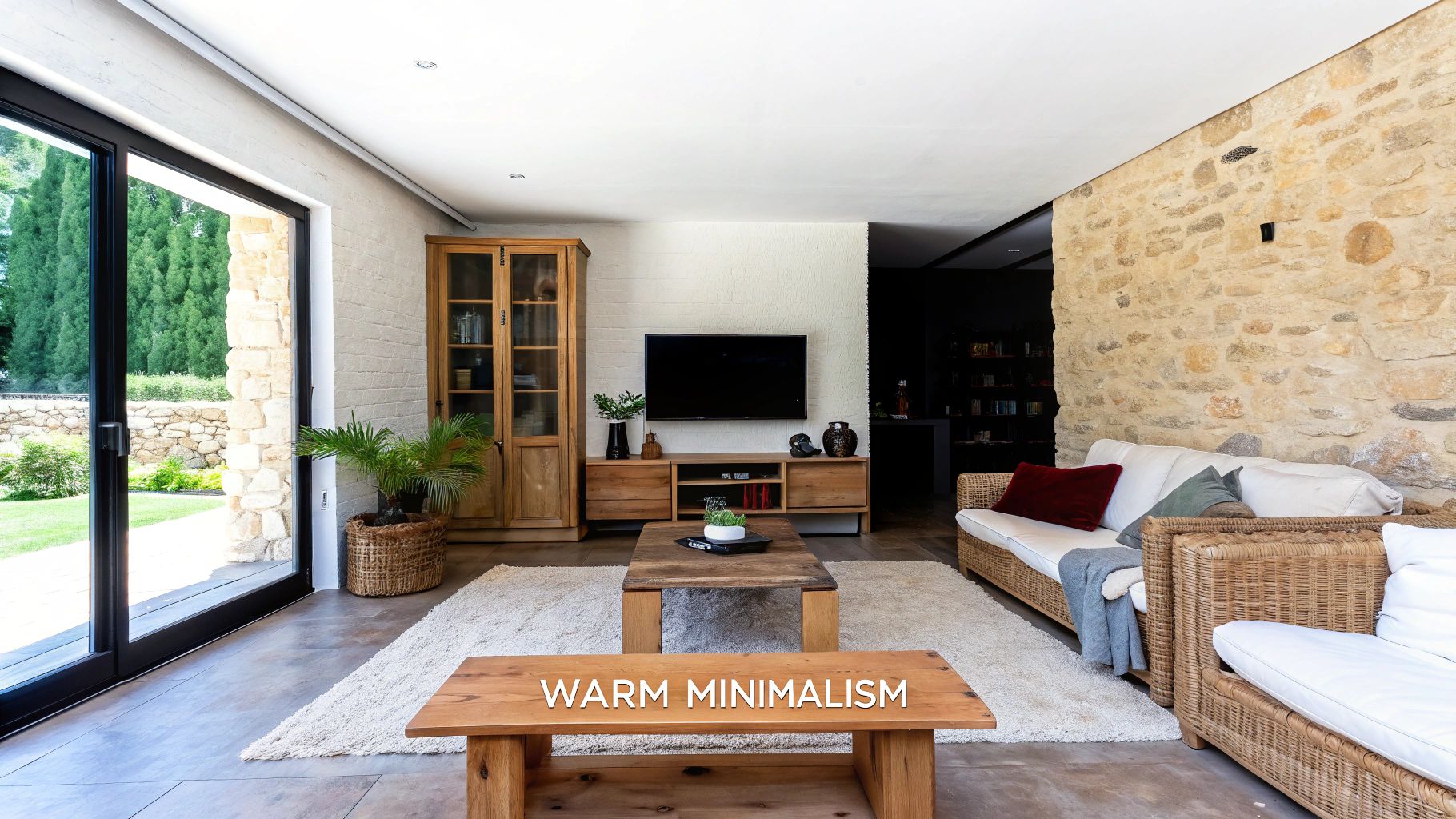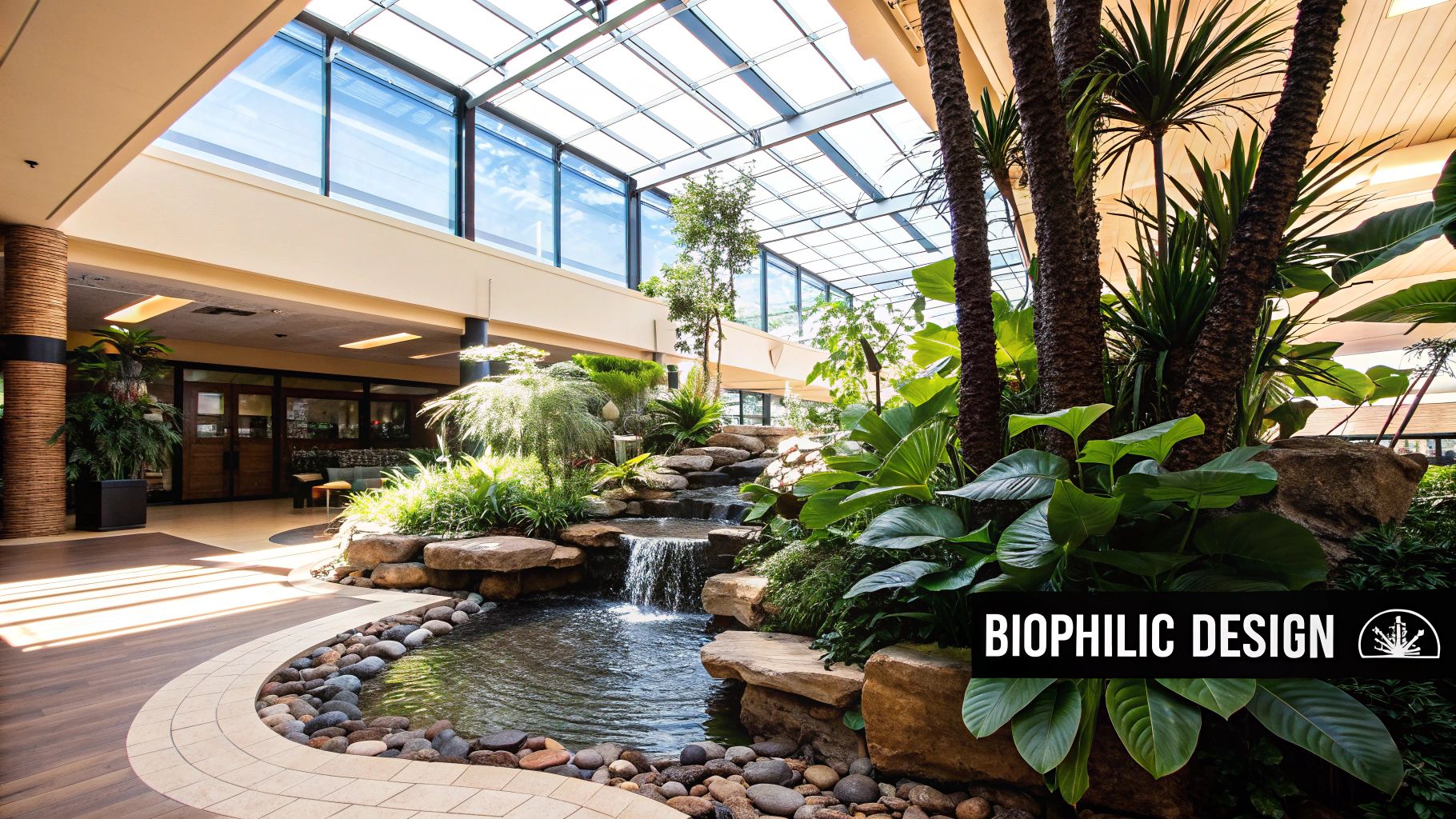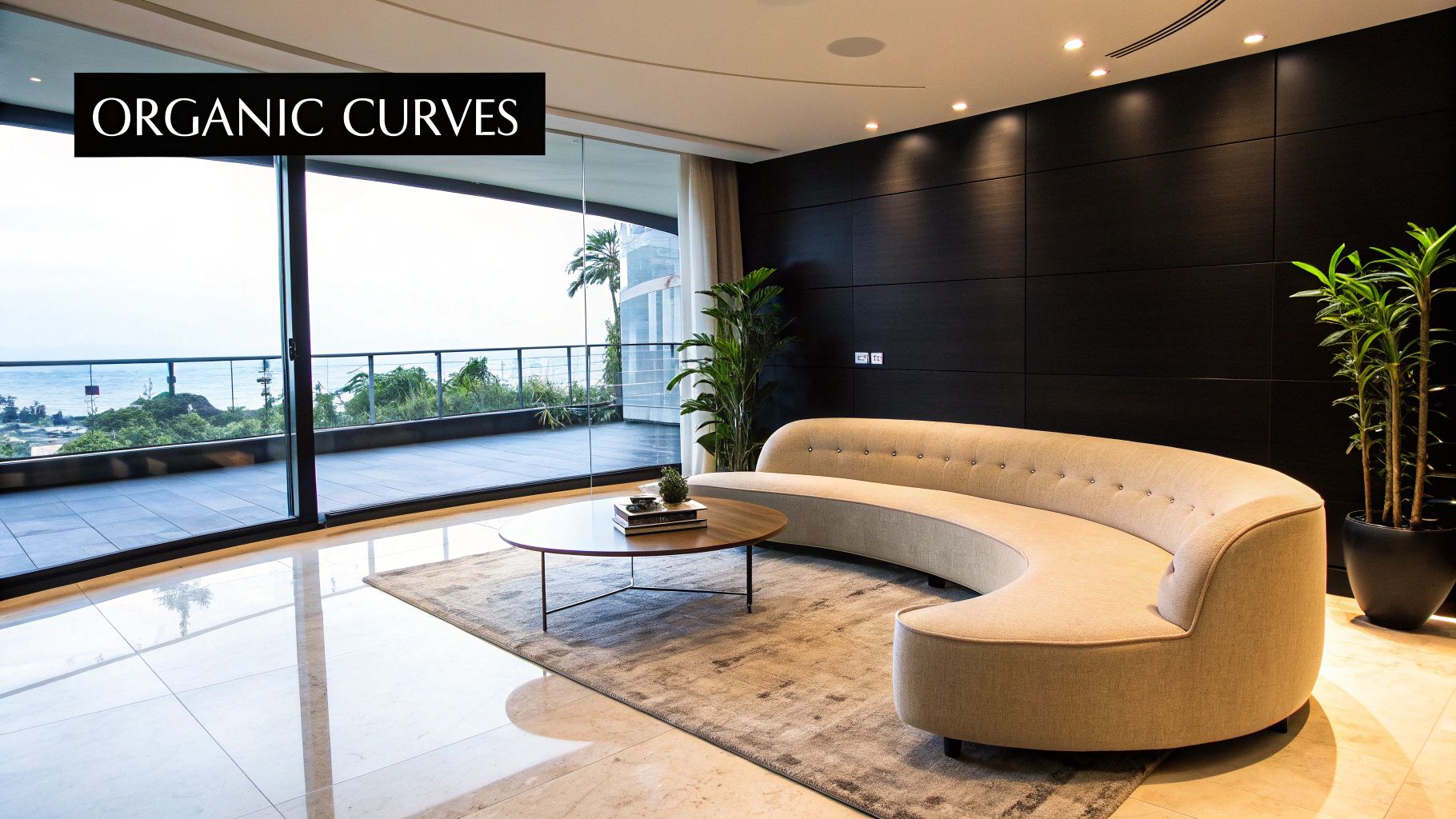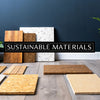9 Bold Interior Design Trends 2024 Still Shaping NZ Homes

Your Guide to Today's Most Influential Interior Styles
While 2024 may be in the rearview mirror, its impact on our living spaces is more relevant than ever. The most innovative interior design trends 2024 have evolved from fleeting fads into enduring styles that continue to shape how we craft our homes in New Zealand. This guide explores the top 9 trends that have proven their staying power, offering a blueprint for creating spaces that are not only stylish but also deeply personal, sustainable, and functional.
From the calming embrace of Warm Minimalism to the joyful rebellion of Dopamine Decor, we will delve into the core principles of each trend. You'll find practical, actionable advice on how to integrate these looks into your own home, with a special focus on sustainable practices and how bespoke, locally-made products from Maak Home can bring your vision to life.
Forget generic advice and surface-level tips. This roundup provides a detailed roadmap to mastering the most influential aesthetics currently defining Aotearoa interiors. We will examine specific implementation details, fresh perspectives, and real-world examples to help you create a home that truly reflects your personality and values. Let's uncover the styles that are defining the future of design.
1. Warm Minimalism
Say goodbye to the stark, cold minimalism of the past. One of the most sophisticated interior design trends for 2024 is Warm Minimalism, a concept that proves simplicity and comfort can coexist beautifully. This approach moves beyond sterile white and cool grey, embracing a richer, more inviting palette while honouring the core minimalist principles of uncluttered spaces and clean lines. It’s about creating a sanctuary that feels both intentional and deeply personal, focusing on tactile sensations and the quiet luxury of well-crafted items.

Inspired by the wabi-sabi philosophy of designers like Axel Vervoordt and the functional elegance of Scandinavian studios, Warm Minimalism is less about what you remove and more about what you thoughtfully keep. It’s a design philosophy that champions a “less but better” mentality. This trend is perfect for creating serene residential homes, boutique hotels, or tranquil office environments where focus and calm are paramount.
How to Implement Warm Minimalism
To bring this trend into your space, concentrate on building layers of texture and warmth upon a simple foundation.
- Start with a Soothing Base: Swap pure white for warmer neutrals like ivory, beige, mushroom, or soft greige. These tones create a welcoming canvas.
- Introduce Natural Textures: This is where the "warmth" comes alive. Incorporate materials like warm wood tones (think oak or walnut), linen curtains, bouclé armchairs, jute rugs, and ceramic décor.
- Invest in Quality, Not Quantity: Select a few high-quality, timeless furniture pieces that are both beautiful and functional. A single, well-made sofa or a solid wood dining table makes a greater impact than a room full of clutter.
- Prioritise Soft Lighting: Use layered lighting with dimmable fixtures, floor lamps, and table lamps to create a soft, ambient glow that enhances the room's cosy atmosphere.
2. Dopamine Decor
As a direct and joyful response to years of muted palettes, Dopamine Decor emerges as a key interior design trend for 2024. This vibrant, mood-boosting approach uses bold colours, playful patterns, and sentimental accessories to curate spaces that actively spark happiness and positive energy. It rejects minimalist restraint in favour of expressive maximalism, transforming your home into a personal sanctuary that tells your unique story and makes you smile.

Popularised by the exuberant styles of designers like Justina Blakeney and Sophie Robinson, this trend is all about surrounding yourself with things you love. It’s a celebration of individuality, where a quirky art print, a brightly coloured velvet sofa, or a collection of cherished ceramics take centre stage. Dopamine Decor is perfect for breathing life into living areas, creative studios, or any space that would benefit from a jolt of personality and visual delight.
How to Implement Dopamine Decor
Embracing this trend is about curating joy, not creating chaos. A thoughtful approach ensures your space feels uplifting rather than overwhelming.
- Start with a Focal Point: Choose one bold piece to anchor the room, such as a cobalt blue feature wall, a patterned rug, or a statement armchair in a sunny yellow. Build the rest of your design around this central element.
- Balance with Neutrals: Even the most colourful rooms need a place for the eye to rest. Use neutral elements like a light-coloured floor, a simple wooden coffee table, or white trim to ground your bold colour choices.
- Mix Patterns and Textures: Combine different patterns like florals, geometrics, and abstract prints in varying scales. Layering textures such as velvet, wool, and gloss finishes adds depth and tactile interest to the scheme.
- Curate Personal Accessories: This is where the trend truly shines. Display items that hold personal meaning-souvenirs from your travels, family photos, handmade art, or vintage market finds that bring you joy.
3. Biophilic Design
More than just placing a few potted plants on a windowsill, Biophilic Design is an evidence-based approach that intentionally weaves nature into our built environments. This core interior design trend for 2024 is founded on our innate human tendency to connect with nature, or ‘biophilia’. It involves incorporating natural elements, materials, and forms to create spaces that actively improve our mental and physical well-being. By mimicking the patterns and processes of natural ecosystems, this trend fosters environments that reduce stress, enhance creativity, and boost productivity.

Pioneered by visionaries like biologist Edward O. Wilson and architect Stephen Kellert, this concept is exemplified in world-renowned projects like the Amazon Spheres in Seattle and Singapore's lush PARKROYAL COLLECTION hotels. It’s a design philosophy that recognises the restorative power of the natural world. This approach is ideal for any space where human health and happiness are a priority, from innovative corporate offices and healthcare centres to residential homes that serve as restorative sanctuaries.
How to Implement Biophilic Design
To effectively bring this trend home, focus on creating direct and indirect connections with nature.
- Integrate Living Greenery: Start by introducing a variety of plants. For low-light areas, choose low-maintenance options like snake plants or Zamioculcas zamiifolia (ZZ plants). In darker corners, consider installing dedicated grow lights to help foliage thrive.
- Embrace Natural Materials: Use materials that reflect the outdoor world. Think solid timber furniture, stone benchtops, woollen throws, and linen upholstery. These elements add tactile richness and a sense of grounding.
- Maximise Natural Light and Views: Arrange furniture to maximise views of outdoor greenery. Keep windows unobstructed where possible to allow natural light to flood the space, connecting the interior with the rhythms of the day.
- Incorporate Natural Patterns and Sounds: Use fabrics, wallpapers, or art that feature organic motifs like leaves or wood grain. The subtle sound of a small indoor water fountain can also create a calming, natural ambience.
4. Curved and Organic Furniture
Moving away from the rigid, straight lines that have dominated recent years, one of the most inviting interior design trends for 2024 is the embrace of curved and organic furniture. This trend champions soft, flowing lines and asymmetrical shapes inspired by the natural world, creating spaces that feel more fluid, comforting, and visually dynamic. It’s about introducing a sense of gentle movement and sculptural beauty into our homes, making them feel less constructed and more inherently graceful.

Echoing the pioneering work of designers like Pierre Paulin and Eero Saarinen, this contemporary revival focuses on human-centric design that prioritises comfort and approachability. The absence of sharp corners fosters a relaxed and welcoming atmosphere, making this trend ideal for social spaces like living rooms and dining areas, or for creating a serene retreat in a bedroom. Curved forms can make a room feel larger and improve traffic flow, breaking up the boxiness of traditional room layouts.
How to Implement Curved and Organic Furniture
Integrating this trend is about balancing softness with structure to create a harmonious and sophisticated interior.
- Start with a Statement Piece: Introduce a single, impactful item like a kidney-shaped sofa, a round dining table, or an armchair with a sculptural, curved back. This piece will act as the focal point and set the organic tone.
- Mix with Angular Elements: To avoid a space that feels overly soft or undefined, create contrast. Pair a curved sectional with a rectangular coffee table or a round mirror above a linear console. This balance is key to a polished look.
- Soften Architectural Lines: Use curved furniture to counteract harsh architectural features. A circular rug can soften a square room, while a serpentine sofa can beautifully complement a bay window.
- Consider Traffic Flow: Curved furniture naturally guides movement. When placing pieces like a curved chaise or sectional, ensure there is ample room to walk around them comfortably, enhancing the room's natural flow.
5. Grandmillennial Style
Pushing back against years of minimalist dominance, Grandmillennial Style is making a charming and confident return as one of the most personality-filled interior design trends for 2024. This aesthetic is a heartfelt celebration of the traditional, blending the classic comfort of a grandparent’s home with a fresh, contemporary sensibility. It’s all about embracing chintz, ruffles, needlepoint, and skirted tables, but with a curated, modern eye that avoids feeling dated or stuffy. The look is layered, personal, and unapologetically pretty.

Popularised by tastemakers like Emma Chamberlain and championed in publications such as House Beautiful, this trend finds its footing in a love for stories and heritage. It's not about creating a museum but rather a living, breathing space that feels collected over time. This approach is ideal for homeowners looking to create a unique and deeply personal sanctuary, or for boutique hotels and bed-and-breakfasts aiming for an atmosphere of nostalgic luxury and welcoming comfort.
How to Implement Grandmillennial Style
The key to mastering this look is a confident mix-and-match approach that balances old and new.
- Start with Pattern: Choose one traditional pattern, like a bold floral chintz or a classic stripe, to be the hero of the room. Use it on wallpaper, a sofa, or curtains and build your colour scheme around it.
- Mix Vintage with New: Scour antique shops and online marketplaces for unique furniture with history. Pair a vintage mahogany side table with a modern lamp or place a contemporary art piece above a classic settee.
- Layer Textures and Eras: Don’t be afraid to combine different styles and periods. Layer a needlepoint cushion on a sleek velvet armchair, or place a collection of antique porcelain on a minimalist floating shelf.
- Balance with Solids: To prevent patterns from overwhelming the space, ensure you incorporate plenty of solid colours. A crisp white trim, a block-colour rug, or a plain-hued armchair can provide a visual break and modernise the overall look.
6. Sustainable and Eco-Friendly Design
More than just a fleeting trend, sustainable design has become a foundational principle for conscious living. In 2024, this approach is less about sacrifice and more about smart, sophisticated choices that benefit both your home and the planet. It’s a comprehensive philosophy that considers the entire lifecycle of a product, from responsible sourcing and low-impact manufacturing to its durability and end-of-life recyclability. This shift reflects a growing consumer demand for healthier interiors and a deeper connection to the environment.
Pioneered by forward-thinking companies like Interface and Herman Miller, and brought to the mainstream by brands like West Elm and IKEA, eco-friendly design proves that style and sustainability are not mutually exclusive. This approach is ideal for anyone looking to create a non-toxic, resource-efficient space, whether it’s a family home, a progressive corporate office, or a hospitality venue wanting to showcase its green credentials. It prioritises creating interiors that are not only beautiful but also built to last.
How to Implement Sustainable and Eco-Friendly Design
Integrating sustainable practices into your design can be both rewarding and impactful. It’s about making deliberate, informed decisions at every step.
- Embrace Second-Hand and Vintage: The most sustainable item is one that already exists. Shop at antique stores, vintage markets, and second-hand platforms to find unique pieces with character, saving them from landfill.
- Prioritise Natural and Recycled Materials: Choose furniture and decor made from renewable resources like bamboo, cork, or FSC-certified wood. Look for products incorporating recycled plastics, metals, or textiles to support the circular economy.
- Invest in Timeless Quality: Opt for well-crafted, durable furniture that will stand the test of time, reducing the need for frequent replacements. Quality craftsmanship is a cornerstone of sustainability. For more ideas on how to get started, you can find a wealth of practical advice in our guide to eco-friendly interior design tips in New Zealand.
- Look for Eco-Certifications: Check for reputable labels like GREENGUARD for low chemical emissions, Forest Stewardship Council (FSC) for responsible wood, or Cradle to Cradle for products designed for a circular lifecycle.
7. Maximalist Wallpaper and Bold Patterns
In a bold departure from muted aesthetics, one of the most expressive interior design trends for 2024 is the return of Maximalist Wallpaper and Bold Patterns. This trend champions a “more is more” philosophy, embracing vibrant colours, large-scale motifs, and intricate patterns to create spaces with personality and drama. It’s about making a statement, turning walls into canvases for artistic expression and celebrating visual richness over minimalist restraint.
Inspired by the opulent, hand-painted scenes of de Gournay and the timeless botanical prints of Morris & Co., this trend is being revitalised by contemporary designers like Kelly Wearstler and brands like Rifle Paper Co. Maximalist patterns bring energy and life to a room, making them ideal for creating memorable hospitality spaces, dynamic retail environments, or adding a dose of glamour to a residential home. This approach proves that bold design can be both sophisticated and deeply inviting.
How to Implement Maximalist Wallpaper and Bold Patterns
To bring this powerful trend home without overwhelming the senses, focus on balance and strategic application.
- Create a Focal Point: Use a dramatic, large-scale wallpaper on a single feature wall, such as behind a bed or in a dining room. This creates a powerful visual anchor without dominating the entire space.
- Balance with Solids: When using busy wallpaper, ground the room with solid-coloured furniture and textiles. Pull a secondary colour from the pattern for your sofa, curtains, or cushions to create a cohesive look.
- Embrace Unexpected Places: Think beyond the main living areas. Applying bold wallpaper inside a walk-in wardrobe, on a ceiling, or in a powder room adds an element of surprise and bespoke luxury.
- Experiment with Removable Options: If you're hesitant to commit, removable wallpaper offers a fantastic way to test the trend. For guidance on getting a flawless finish, explore our step-by-step guide to applying removable wallpaper.
8. Mixed Metals
The era of meticulously matching every metallic finish in a room is officially over. Embracing Mixed Metals is a key interior design trend for 2024, championing a more curated and sophisticated aesthetic. This approach involves thoughtfully combining different metal finishes, such as brass, chrome, copper, and black iron, within a single space. It creates visual depth, adds character, and lends a dynamic, collected-over-time feeling that feels both personal and high-end.
Popularised by design icons like Kelly Wearstler and Nate Berkus, this trend is visible everywhere from luxury hotel lobbies to the stylishly layered kitchens of Joanna Gaines. Mixed Metals allows for greater creative freedom, preventing spaces from feeling too uniform or one-dimensional. It’s perfect for kitchens and bathrooms where tapware, handles, and lighting offer ample opportunities for contrast, but it also elevates living rooms and commercial fit-outs with compelling detail.
How to Implement Mixed Metals
Successfully mixing metals is a balancing act. The goal is to look intentional and curated, not chaotic.
- Choose a Dominant Metal: Select one primary metal to be the most prominent finish in the space. This could be the finish for your kitchen tapware or the main lighting fixtures. Use other metals as accents.
- Stick to a Limited Palette: To maintain cohesion, limit yourself to two or three different metal finishes maximum. For example, pair a warm metal like brass with a cool one like chrome and a neutral one like black.
- Distribute Finishes Evenly: Spread your chosen metals throughout the space to create balance. If you have brass cabinet handles, consider a chrome pendant light and a black-framed mirror on the opposite wall.
- Consider Undertones: Pay attention to the undertones of your metals. Warm metals (brass, copper, gold) pair beautifully with warm colours, while cool metals (chrome, nickel, stainless steel) complement cool tones. For an introduction to a classic cool-toned finish, you can explore the versatility of silver.
9. Textural Layering
Moving beyond visual appeal, a key interior design trend for 2024 focuses on the full sensory experience of a space. Textural Layering is the art of combining multiple materials and finishes to create depth, interest, and a tangible sense of comfort. It’s a sophisticated technique that adds richness and complexity to a room without overwhelming it with colour or pattern. This approach is about how a space feels, inviting touch and interaction with every surface.
Inspired by the curated, multi-sensory showrooms of brands like Restoration Hardware and the cosy "hygge" philosophy of Scandinavian design, Textural Layering is about creating an immersive environment. It champions the idea that a home should be a haven, full of delightful tactile contrasts like smooth leather against rough linen, or sleek metal beside warm timber. This trend is ideal for creating inviting living rooms, luxurious bedrooms, and high-end hospitality spaces that feel both refined and deeply welcoming.
How to Implement Textural Layering
To master this trend, think like a stylist, building up layers of different materials to engage the senses.
- Mix a Variety of Materials: Aim to combine at least three to four distinct textures in a single room. For example, pair a velvet sofa with linen cushions, a jute rug, a marble coffee table, and a bouclé armchair.
- Layer from the Ground Up: Start with the floor. Consider layering a smaller, plush rug over a larger, low-pile one to create instant depth and define a zone.
- Incorporate Natural and Man-made: Balance the organic feel of natural materials like wood, stone, and wool with the sleekness of man-made finishes like polished chrome, acrylic, or high-gloss lacquer for a dynamic contrast.
- Don't Forget the Walls: Add texture through wall treatments like limewash paint, grasscloth wallpaper, or timber panelling. Even three-dimensional art can contribute significantly to the room's tactile quality. For more inspiration, you can find a range of top textile design ideas on maakhome.co.nz.
Top 9 Interior Design Trends 2024 Comparison
| Design Trend | Implementation Complexity 🔄 | Resource Requirements ⚡ | Expected Outcomes 📊 | Ideal Use Cases 💡 | Key Advantages ⭐ |
|---|---|---|---|---|---|
| Warm Minimalism | Moderate - requires discipline to maintain uncluttered look 🔄🔄 | Medium - quality pieces can be costly ⚡ | Calming, timeless, inviting interiors 📊 | Small spaces, mindful living, natural light focus 💡 | Timeless appeal, easy maintenance, promotes calm ⭐⭐ |
| Dopamine Decor | High - balancing bold colors and patterns can be complex 🔄🔄🔄 | High - frequent updates may be costly ⚡ | Energetic, joyful, highly personalized spaces 📊 | Creative, expressive, social media-ready rooms 💡 | Boosts mood and creativity, Instagrammable ⭐⭐⭐ |
| Biophilic Design | High - requires knowledge in plant care and installation 🔄🔄🔄 | High - involves living elements and materials ⚡ | Healthier, stress-reducing, nature-connected spaces 📊 | Urban environments, wellness-focused designs 💡 | Improves air quality, stress relief, sustainable ⭐⭐⭐ |
| Curved and Organic Furniture | Moderate - sourcing and arranging can be tricky 🔄🔄 | Medium to High - often pricier pieces ⚡ | Softer, sculptural, welcoming interiors 📊 | Family homes, modern/traditional mix, visual interest 💡 | Comfortable, safer for kids, visually dynamic ⭐⭐ |
| Grandmillennial Style | Moderate - mixing vintage and new styles requires skill 🔄🔄 | Medium to High - sourcing vintage can be costly ⚡ | Nostalgic yet current, personalized spaces 📊 | Vintage lovers, storytelling spaces, sustainable 💡 | Unique, sustainable, timeless with character ⭐⭐ |
| Sustainable & Eco-Friendly | Moderate to High - needs research and sourcing 🔄🔄🔄 | Medium to High - upfront cost can be higher ⚡ | Environmentally responsible, healthier interiors 📊 | Eco-conscious consumers, long-term savings 💡 | Reduces impact, improves air quality, durable ⭐⭐⭐ |
| Maximalist Wallpaper | Moderate - requires careful pattern balancing 🔄🔄 | Medium - can be expensive to update ⚡ | Dramatic, memorable, artistic spaces 📊 | Accent walls, creative visual statements 💡 | Instant focal points, hides imperfections ⭐⭐ |
| Mixed Metals | Moderate - requires balance and good eye 🔄🔄 | Medium - quality metal finishes vary ⚡ | Sophisticated, layered, flexible interiors 📊 | Eclectic, modern, adaptable spaces 💡 | Adds depth, flexible decorating, authentic feel ⭐⭐ |
| Textural Layering | Moderate - balancing textures needs effort 🔄🔄 | Low to Medium - mostly textiles/materials ⚡ | Cozy, inviting, multisensory spaces 📊 | Modern/traditional blends, affordable updates 💡 | Enhances texture without color, sensory appeal ⭐⭐ |
Crafting Your Timeless, Personalised Space
As we've journeyed through the dynamic landscape of interior design trends 2024, a powerful, unifying theme emerges. It’s a collective move away from fleeting, rigid aesthetics towards a more personal, enduring, and conscious approach to creating our homes. The trends we've explored are less about prescriptive rules and more about providing a rich vocabulary to express individual identity and values.
The common thread weaving through Warm Minimalism's quiet comfort, Dopamine Decor's vibrant joy, and Biophilic Design's natural connection is a profound desire for authenticity. These approaches encourage us to design spaces that not only look good but also feel right, supporting our wellbeing and reflecting our unique stories. Whether it’s the nostalgic charm of Grandmillennial style or the bold confidence of Maximalist wallpapers, the goal remains the same: to craft an environment that is a true extension of yourself.
Key Takeaways for Your 2024 Design Journey
To truly master the interior design trends 2024, focus on these core principles:
- Prioritise Personalisation: The most successful spaces are those that tell a story. Don't feel pressured to adopt a trend in its entirety. Instead, select elements that resonate with you, whether it's the gentle arc of a curved sofa or the rich feel of layered textiles.
- Embrace Conscious Consumption: The emphasis on sustainability is not just a trend; it's a fundamental shift. Opting for quality, locally-made items, and eco-friendly materials is an investment in both your home's future and the planet's health.
- Balance is Everything: Creating a harmonious space is about striking the right balance. You can mix the clean lines of minimalism with the bold patterns of maximalism or temper the warmth of natural materials with the sleekness of mixed metals. The interplay between these elements is what creates visual interest and depth.
Your Next Steps to a Transformed Home
Feeling inspired? The best way to begin is by taking small, deliberate actions. Start by identifying the single trend that excites you most. Could your living room benefit from the textural layering of new cushions and a throw, or is your bedroom calling for a serene, nature-inspired wallpaper from our Biophilic collection?
Consider how you can integrate this new element with your existing decor. The beauty of these 2024 trends is their versatility. A Grandmillennial floral print can be modernised with sleek metallic accents, just as a minimalist room can be enlivened with a single, brightly-coloured piece of art. The true value lies not just in updating your home's aesthetic, but in creating a sanctuary that nurtures, inspires, and grows with you over time.
At Maak Home, we champion this philosophy of personal and sustainable design. Our on-demand, zero-waste production of custom fabrics and wallpapers empowers you to bring these trends to life in a way that is uniquely yours and kind to our Aotearoa environment.
Ready to start your transformation and make these trends your own? Explore our collections at Maak Home and discover the tools to build a beautiful, sustainable, and truly personal home.









